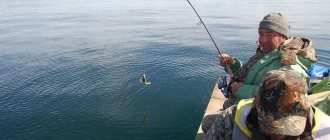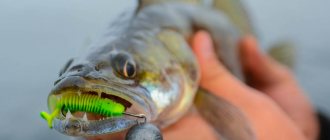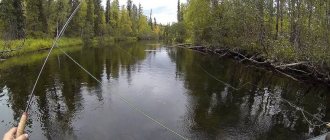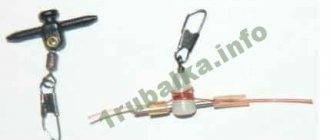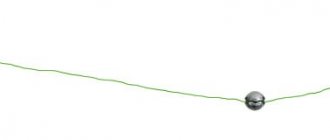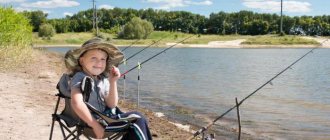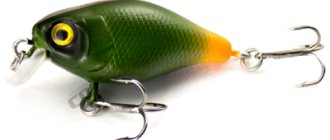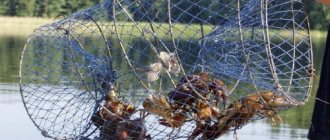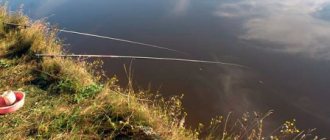Original equipment. The goal is to catch and catch with a jig everywhere and almost always, even if there is no high-quality tackle. The most unhooked “unhooked”.
Advantages and disadvantages of Carolina and Texas jigs. How to assemble them, what is important to pay attention to when installing and fishing.
The most popular in the spinning world, Carolina and Texas rigs allow you to look at jig fishing in a completely different way and achieve simply outstanding results! It is not surprising that these jig rigs are increasingly appearing on the spinning rods of our fishermen, who are successfully applying overseas innovations in their own way. In this article we will talk about these bold fishing experiments, which often bring excellent catches.
From simple to complex
The principle of “shock therapy” in mastering something new is not at all stupid and often leads to amazingly quick results. For example, a person does not know how to swim, but wants to learn. You can study for a long time, doing this in the pool with a trainer, or you can simply throw a person over the side of the boat, and in most cases some instincts will work that allow you, if not to swim, then at least to stay afloat. The parallel with the development of fishing with jig baits is almost direct here. Yes, there are the simplest installations: on a jig head and, a slightly more complicated version, on an eared sinker, with which the hook is connected through a winding ring. And these are excellent rigs that you can fish with for a long time and happily in all bodies of water, and in cases where they are out of use, you can use other baits - wobblers or spoons. But we have set the most important goal - to catch and catch with a jig everywhere and almost always. But fishing everywhere is often hampered by unusual conditions, for example, extensive shallow water, which requires long casting and slow retrieving near the bottom. This is where original equipment can work, and even though it may seem complicated at first glance (more complex than a traditional jig head), and controversial in some respects, it makes it possible to quickly understand many of the features of jig fishing. Moreover, what is especially important for many, it will help you figure it out even if you don’t have high-quality gear, which, as you know, costs good money.
How to fish with a jig
As a result of many years of practice in cultivating this method of catching predators, a certain technique and methods of jig fishing have developed. The use of one method or another depends on the structural conditions of the reservoir and the activity of the fish being caught. We will continue our conversation about the main and most popular methods.
Stepped classic Russian wiring
The method is suitable for various types of reservoirs. After casting and the bait reaching the bottom, the fisherman begins to make two or three turns with the reel, thereby lifting the bait from the bottom and moving it through the water along a stepped trajectory. After a cycle of a series of revolutions, the load is allowed to fall to the bottom, and after a pause of a couple of seconds, the cycle is continued, thus bringing the nozzle to the shore or boat.
Important! If you watch the tip of the rod, then touching the bottom with the bait is marked by its full straightening. The step itself bends the quivertip.
American wiring
This technique is similar to Russian wiring based on the principle of a stepped trajectory of the simulator, only the step is carried out by pulling the bait using the tip of the rod, and not by working with a reel. After several pulls of 20-30 cm, the loosened cord is reeled out and selected, followed by the next rhythmic work with the rod. The method is more labor-intensive than the previous one, but effective in controlling weak bites that occur during pauses.
Wiring for demolition
This is one of the effective methods of jigging in the current. The bait is fed under the drift of the current, starting its animation by waving the rod. At the moment of the swing, the bait is separated from the bottom of the reservoir and is transferred by current forces to another point. The wiring is carried out until the cord is loosened, after which it is reeled in and the spinning rod continues to swing or the equipment is recast again.
Aggressive wiring
Aggressive wiring is used for hunting active pike. The method involves feeding the bait to the bottom, after which, by lifting the rod up, a sharp toss of the bait is made, followed by a pause, at which time the silicone falls back to the bottom. Then, the angler lowers the rod, returning its blank to a horizontal position and rewinds the slack cord.
Uniform wiring
Uniform wiring is carried out by direct winding of the cord after the bait is supplied to the fishing zone. The reel is wound at the same speed, without pauses or any movements with the rod. Silicone with its own play is used as a nozzle. It is possible to catch pike, perch and catfish using the presented technique.
Pendulum wiring
This technique is effective in fishing areas with a snag bottom. With the technology, it is important to position the boat correctly in relation to the trajectory of the nozzle, which reduces the likelihood of snags. The load supplied to the fishing point is placed on the bottom, after which a single and smooth short pull is made with the rod 15-20 cm up, followed by lowering the quiver tip by 5-10 cm and simultaneously winding the loose cord. Repeat cycles are done without stopping.
Short stepped wiring
Short stepped wiring is similar to the Russian type of baiting. The differences in the methods are in a shorter step, which is achieved only by a single revolution of the coil, but performed in a more frequent rhythm. Passive fish are caught using this method. The method works for pike, perch and pike perch.
Caroline "Katyusha" - scout
I propose to mount a jig rig, which one of my friends, who does not like foreign terms, calls it in our own way. "Katyusha". By the way, it is appropriate to note that separate spinning equipment (weight - separately, bait on a leash - separately) is not an American invention at all; similar things were used on our continent in ancient times. Thus, a spinner with a separate load has been successfully used in our country for hundreds of years, and continues to catch today.
But let's return to the Katyusha rig.
The equipment is separate, which complicates casting and possible overlaps. Second: the bait itself is mounted on the hook in a non-snagging version, which threatens a large percentage of unrealized predator grips.
First, about its capabilities. "Katyusha" allows different types of wiring: in the middle horizons - uniform or wavy, a regular bottom step with contact of the sinker with the bottom, etc. But the basic technique is this: the drive is slow, even, from time to time additional short stretches are made - accelerations and short pauses of one or two seconds. During the entire retrieve, the weight stretches along the bottom, raising a small amount of turbidity; the bait on a leash goes just above the bottom, occasionally touching it. One of the most important advantages of the equipment is that with this method of fishing, the weight of the sinker can be increased by two or even three times compared to the weight of the jig head, which is acceptable in these conditions. The increased weight of the load gives us two major advantages: the casting range is significantly increased and it is much easier to control the bottom, even without expensive sensitive gear. The bottom is controlled for the most part by the load itself, it is a kind of plowman, crawling all the time along the bottom, which you will not lose even at significant differences in depth (a load that raises turbidity may have its own attractiveness for a predator, and there are grabs and blows to the load, but equip it with hooks We won’t, otherwise the holds will be tormented).
Its range and good maneuverability through bottom obstacles make the Katyusha a real scout in studying unfamiliar bottom topography and, accordingly, searching for predator sites. After all, the equipment literally “licks” all the differences in the bottom along its path, and without much effort on our part. Of course, if we are working a short, well-studied compact place (a snag, an edge area, a flooded ditch, etc.), then it is more profitable to do this with traditional compact jig rigs - the same jig head. “Katyusha” is an order of magnitude more effective for exploratory fishing in poorly studied places or when a predator wanders around the reservoir and it is very difficult to predict in advance where exactly to fish today - that is, in most cases.
Yes, the equipment is separate, which makes casting somewhat more difficult (at the end of the flight, we slightly slow down the run of the line from the reel with our finger, the leash straightens before splashdown and there will be no tangling) , but the bait on a separate leash plays much better and there are an order of magnitude more bites with a weak bite. After all, as happens when fishing with a jig head: a weak bite - we put a light head so that it “floats” and so that the speed of the retrieve can be reduced. But if you put it too light, you can’t control the bottom, and you can’t cast far. In other words, choosing the right weight of a jig head is often not an easy task, especially when fishing in currents; in any case, you need to have a large set of heads of different weights. There are no such problems with Katyusha: two or three (or even one) sinkers of different weights are suitable for almost all fishing conditions. At the same time, you control the bottom, and the speed of the retrieve can be reduced to a minimum.
But is everything so rosy at Katyusha?
No, of course, there are no ideal rigs, and the next questions are on the way, including doubts about non-catching, sensitivity to bites, etc. But let’s answer possible questions while simultaneously installing the rig, trying to avoid pitfalls in it.
First of all, about the freedom of often forced fishing creativity, which cannot be stifled - cannot be killed by the weak assortment in many of our fishing stores. Carolina rigging will require a little skill and a small set of original things: a special sinker, a special offset hook, a special bait. The latter is a long silicone worm. If you can still buy an offset hook (in extreme cases, you can do without it), then buying sinkers and suitable worms is not always possible. But I propose to ignore these problems and, using the very principle of the Carolina equipment, approach the matter creatively - you can find everything and do it yourself without any problems. So, in order.
Cargo
A reasonable question: is it possible to use a regular Cheburashka with two “ears” instead of a special load? It is possible, but we will encounter two significant drawbacks: the Cheburashka will strongly rake the bottom grass, and most importantly, the equipment will be insensitive to careful bites, which we may not notice and not hook in time. So it’s better to use sliding sinkers with a hole along the axis to let the main line pass through, which will allow you to maintain a more sensitive connection with the bait.
Signature sinkers are designed in the form of a sliding bullet and are made of brass or steel. The shape of the bullet (with the line exiting in the center of the load) is ideal for passing through the grass, and the material allows the load to be ringing, and this “ringing” is built into the design.
Briefly about branded equipment
Bait on a leash. A swivel is attached to the leash. A sliding weight is placed on the main line, then a sliding bead (glass or brass), and the line is tied to the swivel - that's it. When retrieving, the bead hits the hard metal of the weight, and the equipment rings, additionally attracting fish. It is clear that when a bead hits a “blind” lead sinker, you will not get a ringing sound, which is why brass or steel is used. But this is the theory and assurances of Western spinners, pointing out the benefits of ringing sinkers. Sound spinning lures are still probably a separate topic that can become interesting for many, but my survey of familiar spinning anglers, and my own experience, suggests that the effectiveness of the “ringing” is greatly exaggerated, especially against the backdrop of the main attractiveness of the bait itself and turbidity raised by a sinker. Therefore, for those who find the additional fuss with finding steel weights dreary, they can safely eliminate the “ringing” from the equipment, simplifying it and making it cheaper.
Having made this decision, you can already use traditional lead weights, for example, sliding olives or a spherical sliding weight. A good proven option is to use several identical lead olives. By varying their number, it is easy to select a load of optimal weight for fishing in some specific conditions. It is advisable to place a sliding plastic bead or thin cambric between the weight and the swivel. This way we will soften possible shock loads, which can negatively affect both the line assembly and deform the hole in the load, clogging it, which is bad - the line will not slide freely through the load.
But still, the bullet-shaped weight has one significant advantage: if on a clean bottom you place the bullet with the flat part forward, then the sinker will raise much more turbidity when retrieving, which can have a positive effect on the bite, especially for pike perch when it is “nervous” which usually happens after spawning.
Leash
The length of the leash can vary from 30 cm to 1 m and even more (depending on fishing conditions). A short leash makes the tackle more collected, more sensitive, and makes casting easier. A long one helps improve the performance of the bait; in addition, it allows you to move the bait a little higher above the bottom (especially if it is floating), and this point is essential when fishing over a low carpet of bottom vegetation. In addition, a long leash is preferable when fishing in the current, when the equipment is carried along an arc. I have a “starter” leash length of 50 cm, which can be considered universal. use a long leash just for reasons “so that the fish don’t get scared of the load,” because a spinning rod is not a rod, and a load crawling along the bottom does not scare away, but attracts a predator even from considerable distances.
If jig fishing is done with braid, then it is advisable to use a fishing line leash, especially if we are catching a small perch with its easily torn lips - a fishing line leash is a good shock absorber. It’s not worth it to get too thin with the diameter of the leash, especially if we use large pike or zander baits. And only when catching perch with small twisters do you have to use fairly thin fishing lines, at least not thicker than 0.2 mm. For pike, a reliable leash is almost mandatory, because the toothy one often swallows a silicone bait that goes near the bottom at low speed completely. Combined leash: fishing line plus leash. But it is precisely for such separate equipment that it is important to use the most elastic “unbreakable” leashes - tungsten or thin metal cables. After all, we don’t need to spoil the “floating” action of the bait; it was because of the good game that we had already taken the sinker further away, making casting somewhat more difficult for ourselves.
Hook and bait
The length and shape of the hook, as usual, depend on the bait. But what are we going to fish for? Instead of a silicone worm, traditional twisters and even narrow, long vibrotails are perfect. The bait should be long enough so that it can be attached to a normal offset hook. In addition, the bait should have a good tail action even with a slow retrieve.
Now about the more important thing - the hook. A good offset hook is that it is easier and more reliable to mount on the bait in a non-snagging version. But a regular hook with a long straight shank also works fine, which can also be mounted in a non-snacking version (Fig. 2).
Nobody bothers you to put a bait with an open hook, which will hook the fish much more reliably, and when fishing on a relatively clean bottom, this may be the best option. The main thing here is not to let the bait lie on the bottom, which means you shouldn’t stop while retrieving. You can eliminate contact with the bottom, and at the same time diversify the game, by using a floating bait. For example, placing a foam olive or a ball with a diameter of 1-1.5 cm on the leash close to the hook. In the ball along its axis we make a through hole through which the leash line passes and is secured with a plastic stick or a piece of a match. Ideally, the ball will cause the bait to float up slowly. In this case, during wiring, we take frequent pauses, during which the silicone slowly floats up. It turns out to be a kind of inhibited step - a very catchy wiring.
But still, an open hook gives a lot of hooks and is more suitable for short casts, when even if you hook a tuft of grass, the idle retrieve is short and a lot of time is not lost. If you throw far, then you need to be sure that the bait is free of grass. Confidence is given by a bait mounted in an unhooked version. To trust the hook-free bait, you just need to mount it correctly and catch, catch and catch, comparing your catches with bait where the hooks are open. It happens in different ways, and you can end up on a fishing trip where there can be a lot of catches on the unhooked hook (almost several dozen per day), but the catch is very modest. Such unsuccessful fishing trips are remembered for a long time, conversations about it are passed on from mouth to mouth, and the unhooked fish falls into the list of mediocre baits. But it is often forgotten that such cases are few; that many empty grabs occur even on wobblers where there are two or three open tees; that, avoiding grass and snags, you can catch on clean beaches or in the middle horizons, but what will you catch!?
Be that as it may, many spinning anglers are already successfully fishing with silicone non-snagging hooks, which means you can fish. According to my observations, endless idle grips on unhooked hooks are the usual tricks of perch, and not only “sailor fish”, but also decent perches weighing 400-600 g. Pike and pike perch land on a good unhooked hook reliably, according to general statistics, about every other time , that is, the bite rate reaches 50%, and this is a very good result.
Bait selection
Jig fishing in the classic version is carried out with silicone baits.
But with the development of the technology of the method, spinning fishermen unified the baits and were able to introduce a lot of other spinning baits into the method, which proved to be no worse than silicone, and with certain nuances of fishing even gave advantages in catching predators. For the manufacture of baits, a material such as foam rubber was successfully used, which makes it possible to effectively seduce pike perch. Modification of loads according to various load layouts relative to the center of gravity of oscillating and rotating spinners contributes to the hunt for asp and catfish. These types of fishing tools have advanced specialization in equipment for jig fishing, which affects the capture of a certain type of fish. The structural features of baits, their specialization and selection criteria for certain conditions of fishing tactics, as well as the method of loading baits, will be discussed in the continuation of the material with stops on a specific type of fishing accessory.
Silicone baits
Silicones are the most common group of jig baits. Manufacturers produce the main forms of artificial fish in the form of a vibrotail and a twister. Differences in shape, in the structure of the tail part of the instrument. The twister has a long ribbon tail with independent play from the body of the main attachment. The vibrotail is equipped with a short tail element, the so-called hoof, the action of which is formed by the movements of the bait’s body. In addition to the forms presented above for rigs, they use tools in the form of worms, crustaceans, all kinds of insect larvae and beetles, imitating the real food supply of one or another predatory fish.
To improve the attractiveness of silicone, attractants can be included in their composition, giving the bait certain odors that attract fish to the fishing spot. This type of fishing tool is called edible rubber among spinners. The color design of the attachments is very diverse and the colors include all color spectrums, from pure white to jet black. The use of sparkles and fluorescent in the design of the coloring adds efficiency in terms of the number of times the predator goes out to bite.
Silicone works on all freshwater predators without exception and even on some types of peaceful carp fish, such as bream, rudd, carp and crucian carp. More common hunting for silicone is fishing for pike, perch and pike perch. The size of the bait varies from half a centimeter to twenty centimeter baits.
Jig spinners
The spinners used differ from conventional rotating spinners by the additional weight in the front part of the fishing tool. This feature in the structure allows the spoon to go deeper faster after casting and pauses during periods of casting with the front part, which at the moment of falling quite realistically imitates a fry that has lost its orientation by falling to the bottom. Petal shapes are used in classic variants of the structure of the spoon, starting from a drop and ending with a willow leaf. The size and weight of a tool of this type depends on the depth of the hunt and the expected overall parameters of the catch. Silver and copper colors are the highest priority. Using turntables using jig technology, they catch trophy perch, pike and small catfish.
Foam rubber for jig
For the production of foam rubber, dense foam rubber is used, cutting out shapes from the material using ordinary scissors, like a fry with a purlined spindle-shaped body. After forming the image of the fish, the material is painted with markers in the color required for the fishing conditions, and in some cases it is impregnated with a concentrated liquid attractant.
Important! Foam fish are considered a specialized fishing tool for catching pike perch, which readily responds to the clumsy but distinct movements of the fish.
In recent years, many manufacturers have included a foam fishing accessory in their product line and now this product can be purchased in a factory version without any problems.
Jig oscillators
All types of spoons suitable for vertical fishing from a boat are also suitable for jig fishing. The most accurate example of a spinner for this method is a castmaster-type spoon. Depending on the depth of delivery, select the mass of the spinner, mounting it on cords without a swivel, tying it directly to the accessory’s winding ring. Classic oscillating spoons are modified by soldering and peening additional weights in the front part of the tool, which allows the spoon, as in the case of its rotating version, to make steps more clearly when retrieved. Jigs in the fall using jigs produce pike fishing. The catfish fishing season begins with jigs in March in the southern regions of our country.
Nosy "Texas"
This is no longer a “Katyusha”, but a completely different rig - Texas - the most unhooked “unhooked”, in order to plant it somewhere, you need to try hard. The only thing that can stop it is mud, but it is almost impossible for a spinner to fight this scourge effectively. And so “Texas” passes through any grass like a fish - it simply spreads the green and moves on. Three things contribute to such incredible cross-country ability: the same offset hook, the bullet-shaped shape of the sinker and the rigid connection of the sinker with the silicone without any leashes, hinges or gaps.
Due to the fact that it is problematic to buy special weights for Texas equipment, the basic principles of the bait should be stated, and a lead weight can be mounted using improvised means.
So, in the “Texas” the basis is a sliding weight, almost the same bullet-shaped as in the Carolina rig, but with a notch in the rear wide part. The recess includes the front part of the silicone bait, equipped with an offset. In this case, the eye of the hook, after tying the fishing line to it, is recessed into the body of the bait - so that there is no gap between the load and the bait, into which grass can get caught.
Installation of Texas equipment is carried out in the following sequence: equip the bait with a hook; we put a sliding weight on the fishing line; tie the fishing line to the ring of the hook; we pull the weight onto the front of the silicone bait - that’s it.
As you can see, a sliding weight is required only because of the need to assemble all the bait in a certain way. When fishing in thick grass, the weight can fall off the bait and move forward, which is bad, so to be safe, you can secure it by wedging it with a suitable wedge or tying a stop knot on the fishing line and moving it close to the front of the weight.
It is clear that such a bait cannot be quickly replaced with another during the fishing process, so I often mount the “Texas” on leashes, which are attached to the main fishing line. But any fastening element, even a miniature one like a swivel, and even one with a clasp, is a potential weed collector. Therefore, if I plan to fish in thick grass, then I mount the Texas rig directly on the main line without any swivels and fish with one bait - it’s worth it.
conclusions
Despite the fact that the Carolina and Texas rigs are quite similar, in real fishing they are radically different things. Texas rig is an “intelligent” bait that has proven itself best in a light version (no heavier than 10, maximum 15 grams) under the most difficult fishing conditions on lakes and reservoirs. “Texas” is an excellent option for fishing with light and ultra-light spinning rods, when you use thin lines that threaten numerous cliffs.
The Carolina rig is different, confidently catching predators both on lakes and rivers, and with light and heavy loads. Yes, two main reproaches can be brought against this bait: the inability to perform a clear step and insufficient sensitivity to bite. The reproach with the step is justified, but we are not claiming that this is a universal tool. There are other jig rigs for steps.
But I don’t agree about poor sensitivity. The bites are clearly visible, you just need to carefully monitor the wiring of the sinker - an integral part of this interesting bait.
String
The string leash has a very wide application, as it is light, cheap and reliable (photo 6). If we compare leashes made of steel string without fittings and titanium, where fittings are initially present, the first one, with equal strength, will be on average 25% lighter. The fluorocarbon leash, in turn, is heavier than the titanium one by the same 25% with the same length. However, due to the tendency of steel string to curl into a spiral when catching a fish or freeing it from a hook, I try to use the string as little as possible. For example, when catching pike with topwaters. If you still use the string as the main leader in your arsenal, I would pay attention to the fact that the string should in no case be shiny, since the pike will often attack the string, apparently trying to intercept prey from another small predator. And this leads to offensive cuts. You can make any string matte by immersing it in phosphoric acid for a couple of hours. At the same time, it will acquire anti-corrosion properties.
